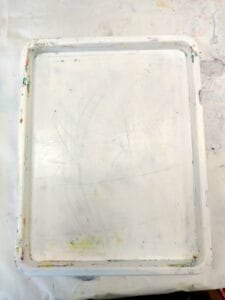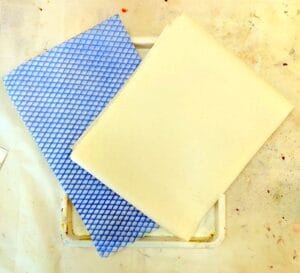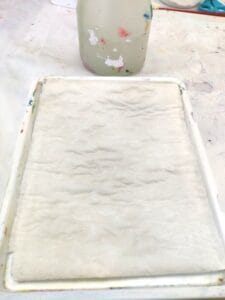I know many people get frustrated with acrylic paint because of the drying times but there are things you can do to make life easier. When setting up your palette, find a tray and place a couple of kitchen towel sheets at the bottom. Next, spray the sheets so that they are wet (not dripping) and place a sheet of greaseproof or tracing paper over them. This will keep your paints hydrated so they won’t dry out. If you still have paint left on your palette at the end of your session, either wrap it in cling film or, if you have a tray the same size or slightly bigger, place it over the paints and they will stay wet and usable for a few days. Do take weather conditions into account.




an old tray tissue or J cloth wet with water tracing paper or baking paper
You will need to take extra care with your brushes. If acrylic paint dries on them, they will never recover. You can put brushes into a pot of water to keep them wet and if you are out on location, you can wrap them in cling film to stop them drying out. I had to throw away several brushes because they dried out, so I started using a palette knife instead. These can be wiped clean with a rag, tissue or wet wipe. The move to palette knives means that I don’t often use brushes with acrylic paint now and if I do I tend to use large house painting brushes.
If you want a smooth finish to your painting, I advise using watercolour brushes which have soft bristles and using some water mixed with your paints. If you are looking for a more textured finish, don’t bother with the water; use the paint straight from the pot, unless you are mixing paints, and apply using a myriad of options out there. Spatulas and cake icing knives can be bought from the kitchen section in your local supermarket. A wander through the aisles of your local DIY/home improvement store will yield plasterers’ tools, plumbing supplies and all sorts of textured items to use with your paint. The bases of food containers, corrugated packaging, string and shop bought stencils could all give you a look which makes you happy.
If you are planning to sell your work (and even if you’re not), once the paint has fully dried/cured – and this can take up to a month, depending on the humidity levels and heat where you work – you will need to add an isolation coat and then varnish the work.
I will share more on this next time.

